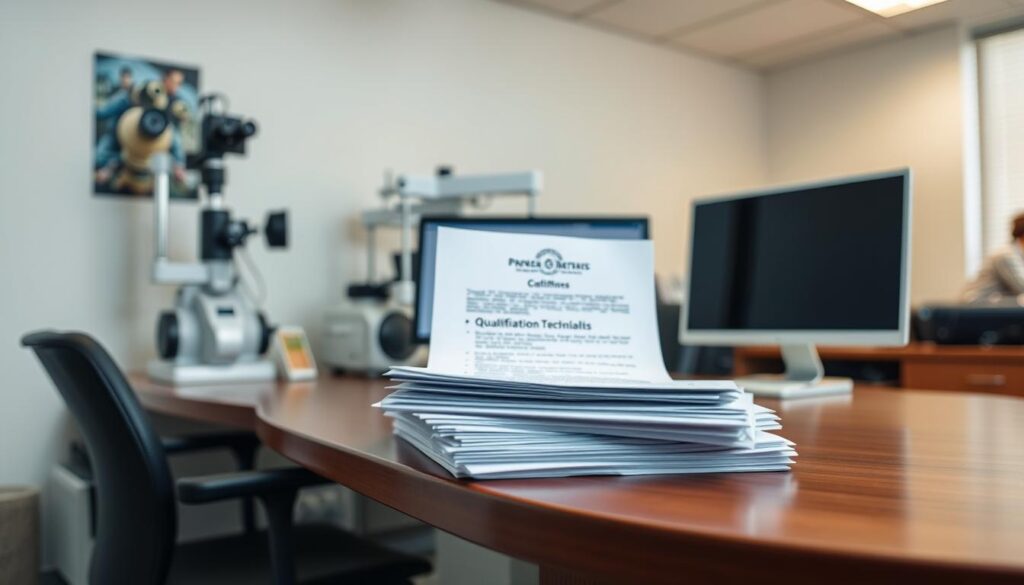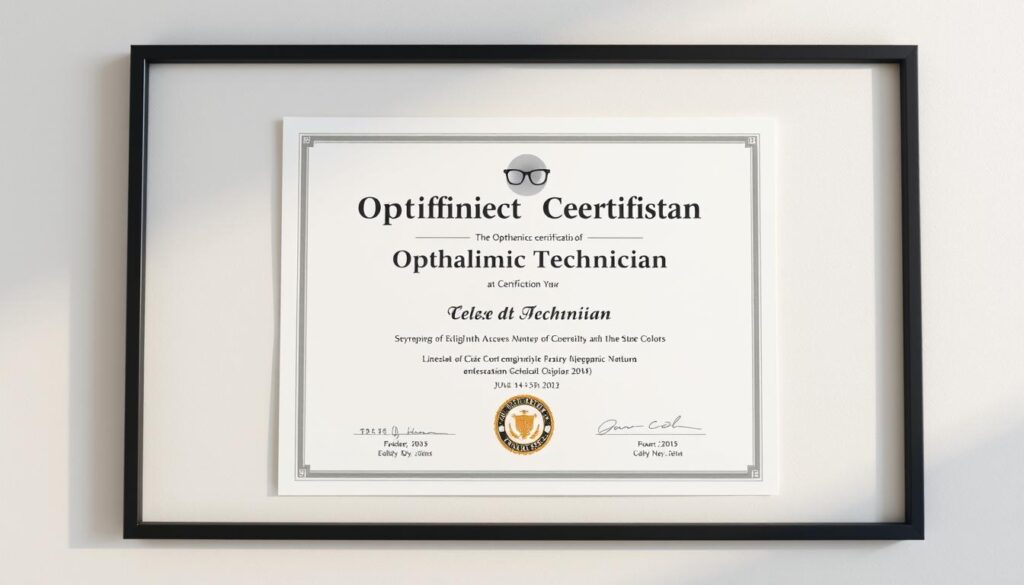What if you could start a healthcare career without a degree and still earn up to $30/hour? The ophthalmic technician role makes this possible, ranking among America’s top 13 healthcare support jobs for its blend of accessibility and growth. This field offers more than just entry-level opportunities—it’s a launchpad for building specialized skills in eye care while advancing your earnings over time.
Newcomers often begin at $10/hour, but certifications and hands-on experience can triple that rate within years. Unlike many medical roles, you won’t need a four-year degree to get started. Instead, focused training programs and industry-recognized credentials pave the way. The key lies in showcasing your technical abilities and patient-care expertise effectively—both on your resume and during interviews.
Tools like RoboApply’s resume builder simplify this process, helping you highlight precision with optical equipment or familiarity with diagnostic tests. With demand rising for skilled technicians, 2025 presents a prime moment to enter this field. Let’s break down exactly how to position yourself for success.
Key Takeaways
- Ranked among top 20 U.S. jobs requiring no college degree
- Entry-level pay starts near $10/hour, reaching $30/hour with experience
- Career advancement tied to certifications and technical specialization
- Combination of clinical training and soft skills drives success
- Automated tools streamline resume creation and interview prep
Understanding the Role of an Ophthalmic Technician
Eye care teams rely on two critical support roles: ophthalmic assistants and technicians. While both work directly with ophthalmologists, their certifications and clinical tasks differ significantly. Let’s clarify these positions to help you identify which path aligns with your career goals.
Job Responsibilities and Daily Tasks
Ophthalmic assistants start their day preparing exam rooms and conducting basic eye screenings. Their core duties include recording medical histories, administering drops, and assisting with minor procedures. Certification (COA) is mandatory for these entry-level roles.
Technicians handle more complex tasks, like performing advanced visual field tests and optical coherence tomography. They triage patients, monitor vital signs, and maintain diagnostic equipment. A COA-to-COT career path requires documented clinical hours and skills evaluations.
Differences Between Assistants and Technicians
Three key factors separate these roles:
- Certification: Assistants need COA, technicians require COT
- Clinical scope: Technicians perform specialized testing like corneal topography
- Patient care: Only technicians prepare operating rooms and educate patients pre-surgery
While assistants focus on data collection, technicians interpret measurements for the ophthalmologist. This progression mirrors the skills ladder seen in other healthcare fields, where technical expertise drives career advancement.
How to Land a Ophthalmic Technician Job in 2025
Employers prioritize three traits when hiring ophthalmology support staff: precision with diagnostic tools, consistent patient rapport, and error-free documentation. Start by targeting high-volume ophthalmology practices—they handle 50+ daily patients and often train entry-level candidates.

Key Requirements and Employer Expectations
Follow this roadmap to meet hiring standards:
- Certification first: Complete COA training even if not required—it shows initiative
- Prove reliability: Highlight attendance records or volunteer roles in healthcare settings
- Quantify accuracy: “Maintained 99% equipment calibration compliance” beats vague claims
Busy clinics value candidates who learn quickly. One hiring manager notes: “We’ll teach technical skills, but work ethic and attention to detail are non-negotiable.” Use your resume to emphasize adaptability, like mastering new EHR systems or handling urgent patient cases.
Entry-level roles often start near $10/hour, but strategic resume formatting can fast-track promotions. Focus on ophthalmology over optometry offices—they offer more advancement paths for certified technicians.
Demonstrate long-term commitment by mentioning continuing education plans. Employers invest in team members who view this as a career, not just a job.
Building a Stand-Out Resume for Ophthalmic Careers
Your resume is your first clinical test in the hiring process. Employers want to see proof of precision and patient care within seconds. Start by trimming unrelated experiences—replace “dance team captain” with healthcare volunteer roles that demonstrate transferable skills.
Showcase What Matters
Use RoboApply’s AI resume builder to highlight:
- Patient interaction hours from nursing homes or rehab centers
- Equipment maintenance logs showing attention to detail
- Certification progress (COA/COT) with completion timelines
Beat the Tracking Systems
Clinic managers receive 120+ applications per job opening. RoboApply’s ATS optimizer ensures your resume clears automated filters by:
- Matching keywords like “visual acuity testing” and “EHR documentation”
- Formatting sections for quick scanner recognition
- Prioritizing clinical terms over generic phrases
One recent user landed interviews at 3 practices by reframing retail experience: “Trained 15 staff members on POS systems → Educated patients on contact lens care protocols.” This strategic pivoting works—especially for entry-level candidates building ophthalmic-specific credentials.
End with a certification roadmap. Example: “Pursuing COT through JCAHPO – 40/120 clinical hours completed” shows ambition. Pair this with RoboApply’s job tracker to align your resume with specific clinic needs.
Mastering Essential Ophthalmic Skills
Success in eye care hinges on blending clinical precision with technical mastery. Your ability to gather accurate data and operate specialized equipment directly impacts patient outcomes. Let’s explore the competencies that separate competent technicians from exceptional ones.

Core Clinical Skills and Technical Competencies
Start with vision testing. You’ll record acuity using standardized notations like 20/20 or 20/50. Mistakes here can delay diagnoses. Practice identifying PERRL (pupils equal, round, reactive to light) and RAPD (relative afferent pupillary defect) – these assessments reveal neurological issues.
Eyedrop administration requires steady hands. Tilt the patient’s head back slightly, then place drops in the lower conjunctival sac. Avoid touching the dropper to the eye to prevent contamination. Pair this with thorough history taking – ask about medications, allergies, and family eye conditions.
Utilizing Diagnostic Tools Effectively
Master three key devices:
- Autorefractor: Measures refractive errors – note OD (right eye) and OS (left eye) separately
- Slit-lamp: Adjust illumination angles to examine corneal layers
- OCT machine: Capture retinal scans by aligning laser beams precisely
One clinic director emphasizes: “Technicians who spot abnormal measurements in visual field tests prevent 30% of misdiagnoses.” Calibrate devices daily and document findings using clinic-approved formats. For advanced roles, clinical documentation skills become critical when preparing surgical reports.
Stay updated on new technologies like corneal topographers. These map curvature changes affecting contact lens fittings. Your technical agility keeps practices competitive while ensuring patient safety.
Leveraging RoboApply Features for Job Success
Your toolkit for securing an ophthalmic position just got smarter. RoboApply streamlines every step—from crafting clinic-ready documents to managing multiple applications. These tools help bridge experience gaps while showcasing your technical aptitude.
AI Resume and Cover Letter Builder
RoboApply’s AI analyzes job descriptions to highlight your most relevant skills. The system suggests:
- Clinical keywords like “tonometry” or “visual field mapping”
- Patient care metrics from internships or volunteer work
- Certification progress aligned with employer requirements
One user reported: “The cover letter builder helped me connect my retail experience to patient education skills—landed 3 interviews in two weeks.” Pair this with the interview coach to rehearse responses about equipment protocols or emergency scenarios.
ATS Optimizer, Auto-Apply Extension, and Job Tracker
Clinics use applicant tracking systems to filter 70% of resumes before human review. RoboApply’s optimizer:
- Formats headings for scanner recognition
- Prioritizes keywords from top jobs in your area
- Flags missing credentials like CPR certification
The auto-apply extension submits applications to 10+ listings hourly while tailoring each submission. Track responses through the dashboard, with reminders to follow up after 5 business days. This system helps technicians manage competitive markets efficiently—especially when balancing job training with active searches.
Effective Interview Strategies for Ophthalmic Technicians
Interviews in eye care test more than technical skills—they assess how clearly you communicate complex concepts. Prepare to discuss clinical scenarios using precise terminology while demonstrating your fit for the practice’s workflow.
Demonstrating Clinical Knowledge and Jargon
Use terms like astigmatism, tonometry, and refraction naturally when describing past tasks. For example: “I measured cylinder measurements during autorefractor tests to identify corneal irregularities.” Explain how you’d handle a glaucoma patient’s follow-up or recognize symptoms requiring urgent ophthalmologist review.
Ask specific questions about equipment: “Which OCT models does your office use for retinal imaging?” This shows familiarity with tools like visual field machines and corneal topographers. Mention JCAHPO certification goals—it signals commitment to advancing in the field.
Tips for Acing the Interview Process
Practice explaining basic eye anatomy using diagrams. Describe how you’d educate patients about cataracts or post-surgery care. Highlight soft skills: “I calm anxious patients by explaining each step of pupillary distance measurements.”
Bring a portfolio with calibration logs or training certificates. Arrive early to review common ophthalmology medications listed on the practice’s website. End with a proactive statement: “I’m eager to learn your EHR system and support your team’s diagnostic workflow.”
Certifications, Training, and Career Advancement
Certifications act as career accelerators in eye care, opening doors to specialized roles and higher earnings. The Joint Commission Allied Health Personnel (JCAHPO) sets the gold standard with three-tier credentials recognized nationwide. Each level builds on the last, creating clear pathways for growth in this dynamic field.

JCAHPO’s Career-Building Credentials
Start with the COA (Certified Ophthalmic Assistant) – it requires 1,000 clinical hours and a written exam. From there, advance to COT (Certified Ophthalmic Technician):
- Pass a practical skills test in seven areas like corneal topography
- Document 2 years’ experience under an ophthalmologist
- Show proficiency in advanced diagnostic equipment
Top-tier COMT certification demands leadership abilities and expertise in surgical prep. One clinic manager notes: “COT holders earn 22% more than non-certified staff – the ROI on exams is undeniable.” Renew credentials every three years through JCAHPO’s continuing education program.
Lifelong Learning for Career Growth
Stay current through workshops on emerging technologies like OCT angiography. Many allied health personnel use CE credits to specialize in:
- Pediatric ophthalmology techniques
- Glaucoma management protocols
- Refractive surgery coordination
Consider stacking certifications – combining COT with pharmacy technician credentials makes you invaluable in surgical centers. Annual conferences like Vision Expo West offer hands-on training while fulfilling JCAHPO requirements.
Pro Tip: Use JCAHPO’s practice exams and study groups to prep efficiently. Technicians with level certification often transition into supervisory roles or clinical research positions within 5 years.
Gaining Practical Experience: Internships and Volunteering
Building a foundation in eye care starts with strategic experience that mirrors clinical environments. While shadowing lets you observe professionals, hands-on roles develop the skills employers demand. Prioritize positions where you actively engage patients or handle medical equipment.

Where to Start: Actionable Pathways
Volunteer at nursing homes or rehab centers to practice vital care skills. These settings expose you to elderly patients – the primary demographic in ophthalmology clinics. Document tasks like recording vital signs or assisting with mobility – they translate directly to pre-testing procedures.
Formal programs accelerate your readiness:
- Two-year associate degrees at community schools combine classroom learning with externships
- 1-year internships (2,000+ hours) meet certification requirements for entry-level roles
- Hospital volunteer programs often train participants in basic diagnostic tools
One clinic supervisor advises: “Candidates who’ve bathed hospice patients or managed dementia behaviors adapt fastest to our workflow.” Even non-eye roles matter – highlight transferable skills like sterilization protocols or EHR navigation in your healthcare resume.
Save shadowing for after you understand basic terminology. Come prepared with questions about OCT interpretations or patient education techniques. This targeted approach turns observation into actionable learning.
Conclusion
Breaking into eye care offers more than steady pay—it’s a pathway to mastering medical technology while improving lives daily. This field rewards those who combine clinical precision with patient empathy, offering clear advancement from entry-level roles to specialized positions. Certification remains your strongest leverage, with JCAHPO credentials directly boosting earning potential and job stability.
Focus on building hands-on experience through internships or volunteer work. Highlight technical skills like OCT operation and EHR navigation—these set you apart in competitive markets. Remember: employers value candidates who view this as a long-term career, not just a temporary role.
RoboApply’s tools simplify every step, from optimizing resumes for clinic-specific keywords to preparing for scenario-based interviews. Start today by outlining your certification roadmap and practicing patient education techniques. With dedication and the right resources, you’ll position yourself at the forefront of this growing healthcare sector.
FAQ
What’s the difference between ophthalmic assistants and technicians?
Ophthalmic assistants handle basic administrative tasks and preliminary patient assessments, while technicians perform advanced clinical duties like optical coherence tomography (OCT) and visual field testing. Technicians typically require JCAHPO certification (e.g., COT) and deeper knowledge of diagnostic tools.
Do I need certification to work as an ophthalmic technician?
While not always mandatory, most employers prefer candidates with JCAHPO certifications like COT or OSC. Certification demonstrates proficiency in core skills such as tonometry, refractometry, and EHR documentation, aligning with Joint Commission standards for allied health roles.
How can I make my resume stand out for ophthalmic jobs?
Highlight technical competencies (e.g., slit lamp operation, retinal imaging) and certifications. Use metrics like “performed 20+ visual acuity tests daily” and link to allied health training programs. Tools like RoboApply’s AI Resume Builder can optimize for ATS keywords like “ophthalmic history taking” or “allied health personnel.”
What clinical skills are most critical for entry-level roles?
Mastery of core skills like applanation tonometry, pupillary evaluation, and lensometry is essential. Employers also value experience with EHR systems like NextGen and familiarity with ophthalmology practice workflows. Shadowing an ophthalmologist or volunteering at clinics helps build these competencies.
How does JCAHPO certification impact career advancement?
JCAHPO credentials (e.g., COA to COT) validate your expertise and open doors to higher-paying roles. Many ophthalmology practices require certification for senior positions. Continuing education through platforms like Ophthalmic Edge keeps skills current with evolving eye care technologies.
Can internships substitute for formal ophthalmic training?
Hands-on internships complement but rarely replace structured programs. For example, a 6-month internship at a Joint Commission-accredited clinic paired with a commission-approved course ensures you meet employer expectations for both technical and soft skills.
What interview questions should I prepare for?
Expect scenario-based questions like “How would you handle a patient with sudden vision loss?” Demonstrate knowledge of ophthalmologist workflows and use industry jargon (e.g., “pachymetry,” “A-scan biometry”). Practice explaining complex tasks like IOL calculations in simple terms.
How important is ATS optimization for ophthalmic job applications?
Critical. Use RoboApply’s ATS Optimizer to include keywords like “allied health personnel” or “ophthalmic assistant technician.” Formatting tips: list certifications (e.g., CPOA) under a “Credentials” header and quantify achievements (e.g., “Reduced patient wait times by 15%”).

















